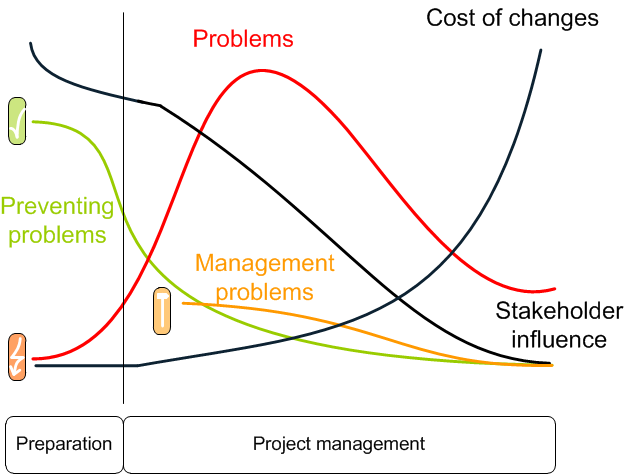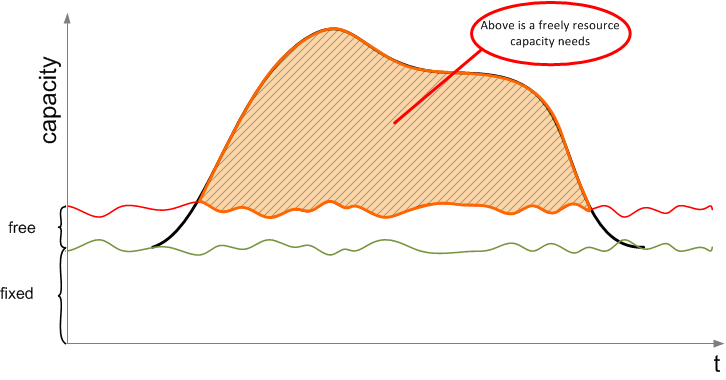Investment support
Investment = value creation! It s value depends on the extent of realization of course.
Problems of investments
More than half of the Hungarian IT investments perform worse than it would be expected before.
Every third investment exceeds the planned deadline. Every fourth investment exceeds the budget.
So the net present value (utility from the customer’s point of view) of investments produces weaker results than the planned business expectations.

The poor performance of investments can be traced back to seven failure factors:
1. Changing of project scope
- Poorly defined original scope
- Poorly surveyed customer needs
- Poorly surveyed changing processes
- Unpredictable changing processes
2. Underestimation of costs/deadlines
- Overoptimistic attitude
- Shortage of experiential value base
- Critical financial or time constraints
3. Insufficient support from the top management
Inefficient information:
- about expected results
- about expected risks
- about the method of needed support
4. Misunderstanding regarding the final product of the project
- Poorly surveyed customer needs
- Poorly documented goals, products
- Poorly ordered implementation
5. Changing of conditions
- In a predictable manner
- In an unpredictable way
6. Insufficiency of resources/resource coordination
- Scarcity of resources
- Lack of PMI and PM competence
7. Personal resistance outside the project team
- Poorly surveyed stakeholders
- Poorly surveyed direct and indirect motivations
These factors can only partly be resolved by classic project management activities, because, in most cases, the effective handling can only be realized before the foundation of the project, in the preparation phase of investment. Other characteristics of the projects that the stakeholders’ influence is the highest in the preparation phase, and the costs of changes are at their minimum. So in case we make mistakes in the preparation phase, they can be only corrected partly with higher costs in the further phases of the project.

One example among many: Investments have to answer business needs. If they make mistakes during the translation of business needs to IT needs, or the IT needs were specified in a wrong way, or the supplier wrongly interprets the specified IT needs, the answer – product in our case – will respond for an unasked question!
Issues of resources
Human resources like other resources are scarce. It is a deteriorating resource, there is no possible way to store it, so it has to be used immediately. Because of this characteristic HR experts are trying to adjust the needs of this resource to the continuous work resource-needs with only a little free capacity.
Projects are rarely parts of continuous work activities, so they mean extra capacity requirements than daily resource needs.

If the projects appear as periodic peak loads, external resources can be good solution, because:
- we are able to use them only in the extent of load and we do not have to pay for them in downtimes
- they are able to choose the appropriate competency from broad group of experts
- they are able to bring new approaches to the project as outsiders
As a summary:
- On the customers’ side we have to allocate the most of the resources and competence in the preparation phase!
- In case we lack extra human resources and projects appear as capacity peaks, we have to take care of appropriate external capacity!
- We have to handle the failure factors!
- We have to maximize the efficiency of investments!
The solution is in the preparation and professional implementation
1. Investment planning
Definition of business, organizational and management needs, planning of feasibility, specification.
Defining needs
- Defining of stakeholders (ha simán megnevezés akar lenni, akkor identifying)
- Reconciliation of goals, priorities and critical success factors
Feasibility study
- Development of solutions aiming defined goals according to the definition document of requirements
- Description of solutions, decision support
2. Tender management
Specification of business, organizational, management and IT needs, compilation of tenders, tender announcement, evaluation, preparation of decision
Assessment phase
- Determining the rules of cooperation, namely defining the project
- Reconciliation of clients’ expectations, needs
- Collecting the technical, formal and evaluation requirements for tenders
Tendering phase
- Creation of the call for applications, the Tender Invitation document and the draft contract.
- The supervisor accepts the documents
- The supervisor transacts the invitation, answers the arising issues and receipts in the offers
- The supervisor forwards the tenders received
Decision-making phase
- Evaluation of received tenders according to the preliminary criteria
- Exclusion of applications with problems of form or content
- Recommendation of winner according to the previously defined criteria
3. Project management
Project foundation, administration, project management, technical representation, keeping contact with suppliers, resource optimization.
Initiation
- Establishment of the project
- Definition of project framework
Planning
- Determination of goals, tasks, critical success factors, responsible operators
- Determination of schedule
- Acceptance of the Project Definition Document
Implementation, monitoring, surveillance
- Regular project managerial meetings with entrepreneurs
- Monitoring, amendment of schedule, enforcement of keeping deadline
- Project administration
- Problem solving
Closing
- Decision support for closing
- Project closing
- Evaluation of project experiences, learning from the project
4. Project quality assurance
Professional representation, professional audit, quality coordination.
In the initiation, planning phase
- Preparation of project defining document (PDD).
- Preparation of sketch, recommendation for setting responsibilities and roles.
- Contribution in development and reconciliation of the project framework.
- Contribution in preparation and controlling of project plan / work plan.
In the implementation, monitoring, surveillance phase
- Random checks of interview process.
- Participation in regular project leader meetings
- Control, reviews, occasional correction of regular and extraordinary memos
- Control of cross-project, preliminary data; review of delivered product
- Revision of products showed in bidding, and the given preliminary documents produced according professional aspects.
In the closing phase
- Proposals for reception, creating errata from the data of the cross-project, project-closing and submitted document reviews.
- Creation of a summary and a decision helping verbal presentation about the collected products experience according to professional aspects, which contains suggestions for acceptance, optional conditions, based on inadequacies listed in the errata.


